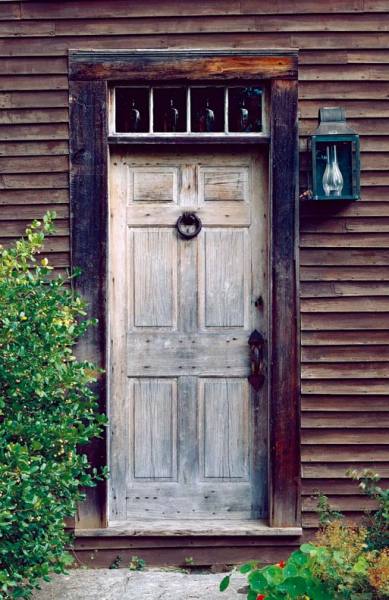
Station oil lamp (Photo: Paul Rocheleau)
There’s a reason why so many historic districts offer guidelines on porch lights: It’s easy to choose the wrong one. We’ve all seen houses that are historically accurate down to their mousetraps, yet sport those oversized carriage lights mistakenly associated with the Colonial era. (We aren’t sure why those came into fashion, exactly, but that’s another story.)
Determining what kind of porch light is appropriate for your old house can be tough because lights are such ephemeral objects. Fashions change, and lights are subject to changing more often than most house parts owing to their small size and the big cosmetic punch they carry. In addition, the thinking on what makes a light right has varied over time. Take, as one example, a 1932 issue of Home Architecture, which advised that “good entrance lighting will brighten the doorway, emphasize its architectural charm, light the faces of guests, and radiate a cheerful hospitality.” Yet, when it came to specifics on the placement and style of those entrance lights, the same article offered up a laundry list of options considered appropriate at the time: brackets or lanterns, wall-mounted or ceiling fixtures, lights hung above the door, or lights flanking it.
The good news is more than one light type can be the right choice, as evidenced by the wide array of originals we’ve spotted on porches through the years. While we can’t be sure of what lit up your porch or front door when your house was new, we can show you some possibilities that are appropriate for a range of architectural styles and eras.
1. Station Oil Lamps
Some of the earliest porch lights were wall-hung oil lamps, such as station lamps, which evolved from hand-held utility lights in the mid-19th century. Featuring a simple whale-oil or kerosene-burning flame inside a glass chimney that was contained within a tin case, this style is known as a square tubular lamp. Widely marketed by manufacturers such as Dietz and Russell & Erwin by the 1860s, the lamp was advertised in an 1897 Sears catalog as giving “very bright light, equal to the best gas jet,” that wouldn’t blow out in a strong wind. While these lanterns aren’t fancy, they are appropriate for vernacular buildings, such as farmhouses.
2. Iron Gas Lights
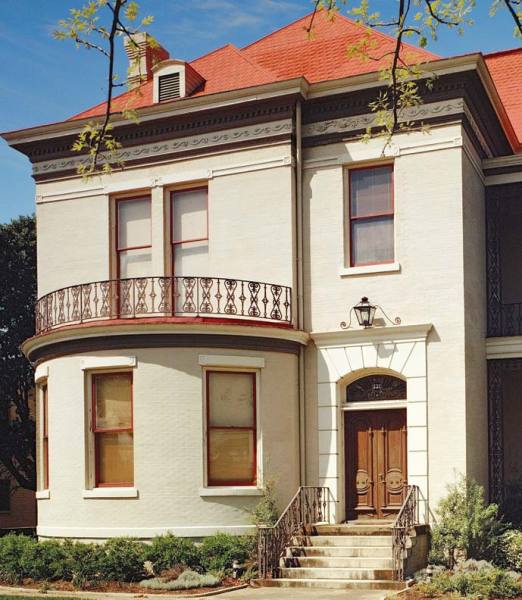
Iron gas light (Photo: Paul Rocheleau)
Typical of the ornamental ironwork popular for gas street lamps at the height of the Victorian era, gas entrance lights featuring fancy scrollwork, brackets, and strapwork supporting panels of seeded or frosted glass became common by the late 19th century. Because they were meant to be decorative, the lights were at home perched above a gate or door, positioned next to one, or sitting prominently atop a post installed beside the sidewalk.Because the earliest versions of these lights were powered by gas, they required vents on their pyramidal canopy hoods. For a time, iron gas lights appeared on houses both grand and small from around 1860 on, as well as all manner of public buildings.
3. Single-Chain Pendants
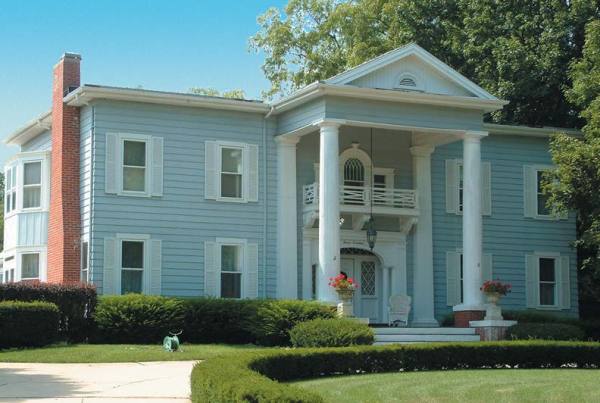
Single-chain pendant (Photo: Peter Barr)
Grand houses required porch lights that made a statement as well as accounted for high ceilings. Born from the candle-bearing lanterns of yesteryear, electric pendants appearing in the 1890s were cast of iron or brass and suspended from a long chain that hung prominently from a sweeping, two-storey porch (see page 52). This type of light was a perfect fit for a variety of formal houses from Neoclassical Revival to early Colonial Revival. The design of the fixture varied and came in a wide range of shapes, including hexagonal, four-paneled, coach style, or even cylindrical, with glass panels ranging in color from clear to amber. Often, these panels were nestled into decorative scrollwork, and pendants could be modified to suit a variety of houses.
4. Bracket Lights
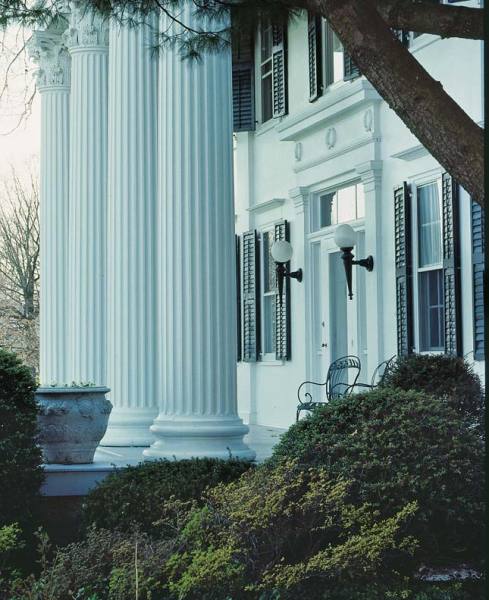
Bracket lights (Photo: Paul Rocheleau)
Bracket lights surged in popularity during the Colonial Revival craze of the early 20th century and often appeared flanking doorways. These early electric lights were inspired by Beaux Arts styling, and typically included decorative molded surfaces bearing details such as cartouches, floral patterns, and medallions. Their forms were varied and often reflected the burgeoning interest in a range of historical lighting fixtures that were rewired for electricity. Cast-iron brackets supporting simple clear or frosted globes, or brackets resembling torches bearing curvaceous shades, can be seen on either side of doors in a range of house styles—from Italian Renaissance to Colonial Revival—dating to the early decades of the 20th century. A 1927 Sears catalog called them “a popular type of porch light known for their neat and attractive appearance.” The fact that they remain some of the most popular models from today’s reproduction lighting companies attests to their enduring appeal.
5. Arts & Crafts Lanterns
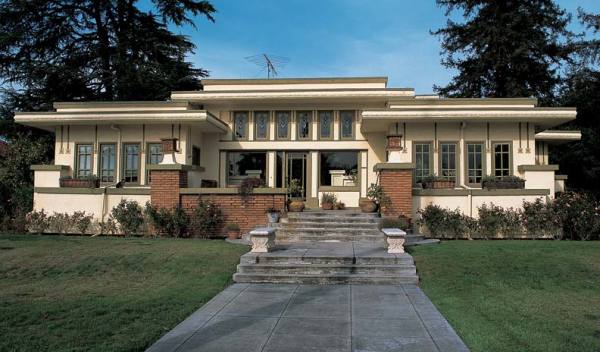
Arts & Crafts lanterns (Photo: Linda Svendsen)
The artisans of the Arts & Crafts movement extended their aesthetic nicely to electric lighting applications already common by the 1910s, such as bracket fixtures and single-chain lanterns, but they also developed a unique porch accessory, one that borrowed heavily from Japanese sensibilities: the column lantern. Perched atop a porch column, a Japanese style lantern—sitting low in either a rectangular or pyramidal shape—would throw soft light.These lanterns could be made of iron or copper and have decorative metal patterns juxtaposed over a colored-glass shade. Stickley himself made note of this type of light in The Craftsman, where he wrote,“The unusual lighting device for the porch is noticed in a modernized Japanese lantern, set on a low pedestal-like pillar, standing at one side of the entrance steps.” In the same publication, he waxed poetic on the large copper column lantern on another house which he found was “in admirable keeping with the general style of breadth and grace, adding a note of welcome at night, throwing a soft, subdued light over everything.”
6. Ceiling Globes
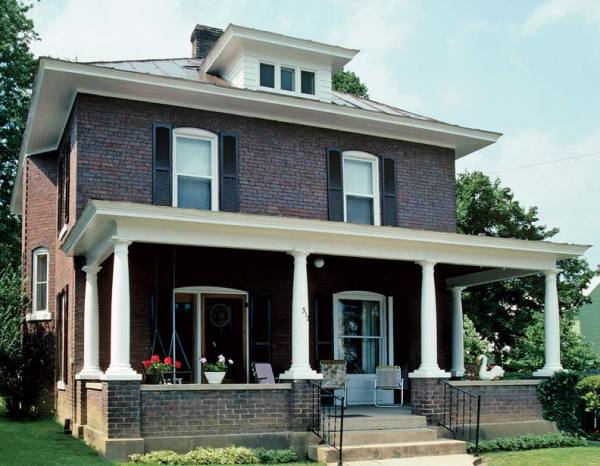
Ceiling globe (Photo: James C. Massey)
The relatively low-ceilinged porches that fronted the smaller houses of the early 20th century called for a fixture that was far less obtrusive.The answer, made possible by electricity’s compact efficiency, was a small, ceiling-hugging, inverted glass globe of one sort or another. Typically set in a cylindrical or pyramidal cast-iron base, these white or frosted-glass fixtures were common by the mid-1910s and understated to the point of being stylistically neutral. Nonetheless, they had a modern appearance that was a comfortable fit with many house styles so that the lights were a ubiquitous fixture on Foursquares and other broadly popular houses well into the 1940s.







